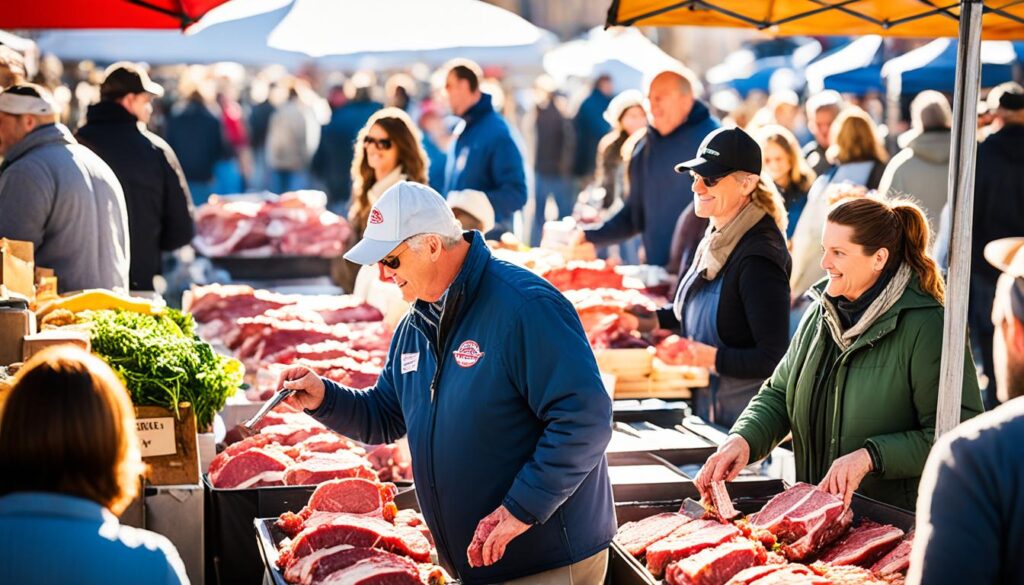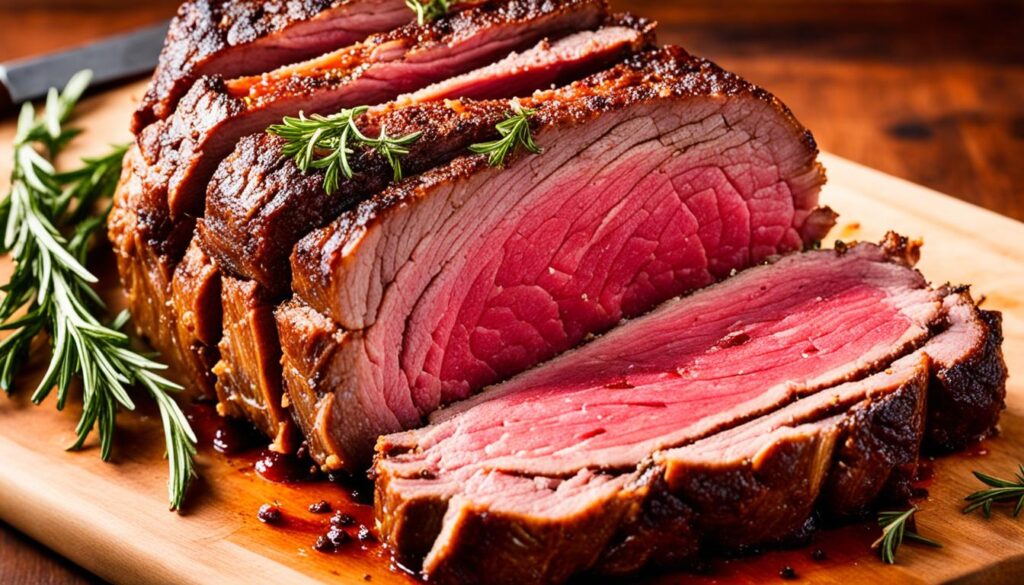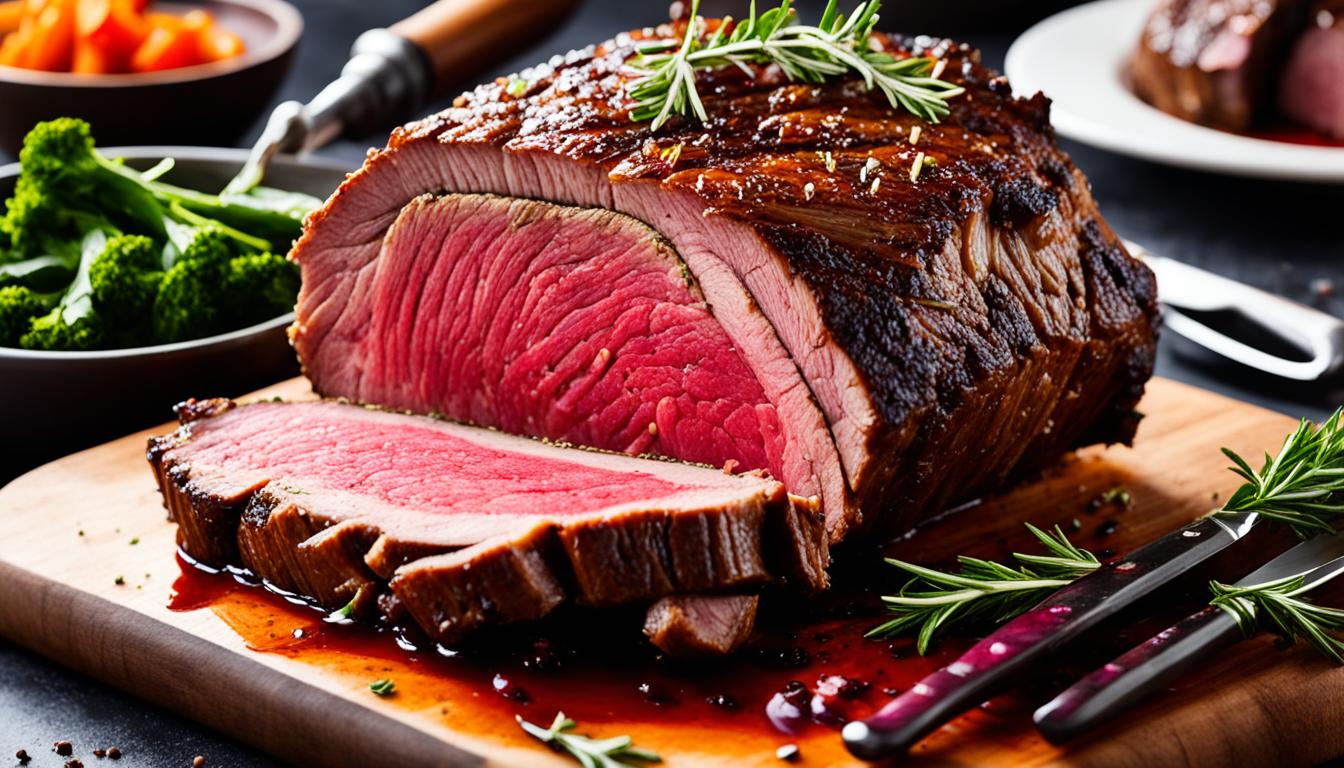Are you ready to master the art of cooking the perfect prime rib? Whether you’re planning a special occasion feast or simply want to impress your loved ones with a delicious meal, prime rib is the way to go. But what does it take to create a mouthwatering prime rib that will have everyone asking for seconds?
Today, we’re sharing our ultimate guide to a perfect prime rib beef recipe. From choosing the best cut of meat to cooking it to perfection, we’ll walk you through every step of the process. Get ready to become a prime rib pro!
Before we dive into the details, let’s first understand what prime rib is and why it’s the star of the show when it comes to meaty perfection. And what if we told you that there’s a secret to achieving the most tender and flavorful prime rib? Curious? Keep reading to uncover the truth about this culinary masterpiece.
What is Prime Rib?
Prime rib is a large cut of beef that consists of a full rack of 7 ribs. It is often referred to as a super high-quality tomahawk or bone-in ribeye. This versatile cut of meat is known for its exceptional flavor and tenderness.
Prime rib can be divided into three distinct parts. The first is the rib cap, also known as the spinalis dorsi, which is considered the best part of prime rib due to its complex flavor and tenderness. The ribeye, which is the main body of the slice, is well-marbled and provides a juicy and flavorful eating experience. The third part is the iliocostalis, also known as the lip or nose, which is a beefy and tender cut located next to the bone.
Whether cooked as a roast or sliced into steaks, prime rib is a popular choice for its rich taste and succulent texture. The combination of marbling and the bone-in nature of prime rib contribute to its exquisite flavor profile, making it a favorite among meat lovers.
When preparing prime rib, it is essential to take advantage of the different cuts within the meat to create a truly sensational dining experience. The rib cap offers complexity in flavor, while the ribeye provides a tender and well-marbled eating experience. This combination of textures and flavors makes prime rib a sought-after option for special occasions and gatherings.
How to Make the Best Prime Rib
To make the best prime rib, it is recommended to use a meat thermometer. This ensures that the meat is cooked to the desired level of doneness. The best kind of meat thermometer is a leave-in meat probe or the probe that comes with your oven.
The cooking time for prime rib varies depending on the size and desired doneness, but a general guideline is 15-30 minutes per pound. This allows for a perfectly cooked prime rib that is juicy and tender. However, the key is to use a meat thermometer to accurately determine the internal temperature of the meat.
By inserting the meat thermometer into the thickest part of the roast, you can avoid overcooking or undercooking the prime rib. The thermometer should read 135°F for medium-rare, 140°F for medium, and 150°F for medium-well. It is important to note that the temperature will continue to rise a few degrees while the meat rests.
Once the prime rib reaches the desired temperature, it is crucial to let the meat rest for 30 minutes before carving. This allows the juices to redistribute, resulting in a more flavorful and moist prime rib.
Using a meat thermometer is the secret to cooking prime rib perfectly every time. It takes the guesswork out of achieving the desired level of doneness and ensures a succulent and tender prime rib that your guests will rave about.
Prime Rib vs Steaks
When it comes to choosing between prime rib and individual steaks, there are a few key differences to consider. Firstly, prime rib offers a more affordable option compared to buying individual steaks. It is a bone-in ribeye that provides a high-quality beef experience at a lower price point. This makes it an excellent choice for those looking to impress without breaking the bank.
Another advantage of prime rib is its ease of cooking. Unlike cooking multiple steaks, which requires careful monitoring of individual doneness levels, prime rib is cooked as a whole roast. This makes it simpler to prepare and ensures a consistent level of doneness throughout the cut.
Furthermore, serving prime rib creates a show-stopping centerpiece on the dinner table. The large, bone-in cut is visually impressive and adds an element of elegance to any meal. It’s a surefire way to make a memorable impression on your guests.
Unlike steaks, which are typically cooked to a specific level of doneness, the beauty of prime rib lies in its versatility. When you cook a prime rib, you can achieve different levels of doneness throughout the cut to cater to various preferences. This means that if you have guests who prefer their beef cooked medium-rare and others who enjoy it more well-done, you can accommodate everyone’s tastes with a single roast.
It’s also worth noting that prime rib can be cut into individual steaks before or after cooking. This allows for greater flexibility in serving sizes and makes it easy to accommodate different portion preferences. On the other hand, steaks cannot be combined to create a prime rib roast, limiting their versatility in comparison.
In conclusion, prime rib offers a more affordable, easier to cook, and visually impressive alternative to individual steaks. Its versatility and ability to cater to different doneness preferences make it a popular choice for special occasions. Whether you’re looking to serve a crowd or enjoy leftovers, prime rib is a delicious and impressive option that is sure to satisfy.
Cooking a Smaller Prime Rib
Looking to enjoy a delectable prime rib but cooking for a smaller gathering? Consider preparing a smaller prime rib that serves two people or smaller households. This allows you to indulge in this mouthwatering dish without the need for a large cut of meat.
To obtain a smaller prime rib, simply ask your trusted butcher to cut a 2-3 rib segment for you. Buying a smaller prime rib section is not only convenient but also more cost-effective than purchasing individual steaks.
It’s important to note that the front and back ribs of a prime rib offer different characteristics. The front ribs are known for being more tender and boast a larger ribeye portion, perfect for those seeking a melt-in-your-mouth experience. On the other hand, the back ribs are more marbled and complex, offering a unique flavor profile.
By cooking a smaller prime rib, you still get to enjoy the impressive presentation and exquisite taste that comes with this beefy delight. Moreover, preparing a smaller portion allows for better control over the desired level of doneness.
If you’re ready to impress your guests or indulge in a splendid meal for two, a smaller prime rib is the perfect choice. Let’s dive into the art of selecting the best prime rib and explore the cooking techniques to achieve perfection.
Choosing the Best Prime Rib
When it comes to selecting the best prime rib, there are a few key factors to consider. One of the most important qualities to look for is good marbling. Marbling refers to the small streaks of fat that are dispersed throughout the meat. A well-marbled prime rib indicates a cut that will be tender, juicy, and full of flavor.
Another factor to keep in mind is whether the beef is grass-fed or corn-fed. Grass-fed beef is known for its distinct flavor and is often considered more natural and healthy. On the other hand, corn-fed beef tends to have a milder taste and may be more tender due to the feeding process. The choice between grass-fed and corn-fed ultimately comes down to personal preference.
When it comes to quality grading, prime rib can be classified into different USDA grades. The highest quality grade is USDA Prime, which is often characterized by its abundant marbling and tenderness. USDA Choice is the next best grade, offering a good balance of quality and affordability. These grades ensure that you are getting a prime rib of consistent quality.
If you’re looking for something beyond the traditional choices, there are other options to consider. Organic prime rib is sourced from animals raised without the use of antibiotics or hormones and adheres to stringent organic farming practices. Dry-aged prime rib undergoes a process of aging that results in intensified flavors and increased tenderness. Lastly, wagyu prime rib offers a unique and luxurious dining experience with its rich marbling and buttery texture.
Remember, choosing the best prime rib is a matter of personal preference and budget. Whether you opt for grass-fed or corn-fed, USDA Prime or USDA Choice, or explore other options like organic, dry-aged, or wagyu, you’re sure to enjoy a delicious and satisfying prime rib experience.
Where to Buy Prime Rib
When it comes to buying prime rib, there are several options to consider. One of the best places to purchase prime rib is from your local butcher. They have the expertise to cut the prime rib to your desired thickness and can ensure that you are getting a high-quality cut of meat. Plus, supporting local businesses is always a great idea.
If you prefer the convenience of a grocery store, you can typically special order prime rib from their meat department. This allows you to customize your order and ensures that you are getting exactly what you want. Just speak to the butcher or meat manager at your local grocery store to arrange the order.
For those who prefer online shopping, there are reputable meat purveyors like Snake River Farms or Costco that offer high-quality prime ribs. They have a wide selection of prime rib cuts available, allowing you to choose the perfect one for your needs. If you are a member, Costco also offers prime rib in their prime beef department, making it a convenient option to consider.

How to Cook Prime Rib
When it comes to cooking a perfect prime rib, following the right steps is crucial. By using a combination of techniques, you can ensure that your prime rib turns out tender, juicy, and full of flavor. Here’s our step-by-step guide on how to cook prime rib:
- Preheat your oven to 450°F (232°C) to create a crisp crust on the outside of the meat.
- In a cast iron pan, brown the prime rib on all sides. This will help to enhance the flavors and create a beautiful caramelized crust.
- Brush the prime rib with butter or oil to add richness and moisture to the meat.
- Place the seared prime rib in the preheated oven and cook at 450°F for 15 minutes. The high heat will help to develop a flavorful crust.
- After 15 minutes, reduce the oven temperature to 200°F (93°C). This lower temperature allows the prime rib to cook evenly and gently.
- Continue cooking the prime rib until it reaches the desired internal temperature. For medium-rare, aim for an internal temperature of 135°F (57°C). Use a meat thermometer to accurately measure the temperature.
- Once the prime rib is cooked to perfection, remove it from the oven and let it rest for at least 30 minutes. This resting period allows the juices to redistribute, resulting in a tender and juicy prime rib.
Now that you know the secrets to cooking a perfect prime rib, you can impress your guests with a delicious and flavorful centerpiece for your next special occasion. Enjoy!
The Secret to Perfect Prime Rib
When it comes to achieving the perfect prime rib, there are a few secrets that can make all the difference. One of the most important factors is using a reliable meat thermometer. This handy tool ensures that your prime rib is cooked to the ideal level of doneness without the risk of overcooking.
By inserting the meat thermometer into the thickest part of the prime rib, you can easily monitor the internal temperature and determine when it is cooked to your desired level. Whether you prefer rare, medium-rare, or well-done, the meat thermometer takes the guesswork out of the equation, guaranteeing a mouth-watering prime rib every time.
Another key secret to perfect prime rib is allowing the meat to rest after cooking. This step is crucial as it allows the juices to redistribute throughout the meat, resulting in a more flavorful and tender final product. We recommend letting your prime rib rest for at least 15-20 minutes before carving to ensure maximum juiciness and deliciousness.
Proper seasoning is also essential in bringing out the natural flavors of the beef. A generous sprinkle of salt and freshly ground black pepper is all you need to enhance the taste of the prime rib. Don’t be afraid to season generously, as the thick cut of meat can handle it and will benefit from the added flavor.
Remember, achieving the perfect prime rib requires attention to detail and a few secrets up your sleeve. By using a meat thermometer, allowing the meat to rest, and seasoning it with care, you’ll be on your way to serving a prime rib that is juicy, tender, and bursting with flavor.
Dry-Aged Prime Rib
When it comes to indulging in the finest flavors and textures, dry-aged prime rib takes center stage. Dry-aging beef is a meticulous process that involves controlled rot and oxidation of fat, resulting in a distinct and intense flavor profile. The beef undergoes a transformation that develops a dense and meaty texture, enhancing the overall eating experience.
Dry-aged prime rib is considered a gourmet option and is highly prized for its tender and nutty taste. Each bite is a symphony of rich flavors that tantalize the taste buds and leave a lasting impression. The complexity and depth of the flavor make it a perfect choice for special occasions and memorable meals.
However, it is important to note that dry-aging beef is a painstaking and time-consuming endeavor. It requires specialized equipment and expertise to achieve optimal results. Tools such as the SteakAger PRO 15 and the Steak Locker are designed to provide the perfect environment for dry-aging beef at home, allowing enthusiasts to enjoy this culinary masterpiece with convenience.

Dry-aged prime rib is a testament to the dedication and passion of those who seek the finest culinary experiences. It embodies the artistry of dry-aging and the skill of the chef who prepares it. The result is a dish that transcends expectations and creates a truly exceptional dining experience.
Leftover Prime Rib
Leftover prime rib can be a delicious and versatile ingredient for creating new dishes. Whether you have a few slices or a whole roast left, there are many ways to repurpose this flavorful meat.
One simple and satisfying option is to thinly slice the leftover prime rib and use it to make roast beef sandwiches. Layer the slices on your favorite bread or roll, and add some horseradish sauce or melted cheese for an extra kick.
If you’re looking for a heartier meal, cube the leftover prime rib and use it in a beef stew or steak pot pie. The tender meat will add rich flavor and depth to the dish, making it a comforting and satisfying option for the whole family.
For a quick and flavorful meal, consider using the leftover prime rib in a classic beef stroganoff. Sauté some onions and mushrooms, then add the sliced prime rib and a creamy sauce. Serve it over egg noodles or rice for a deliciously comforting meal.
